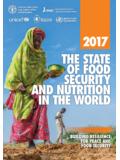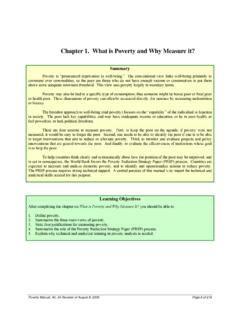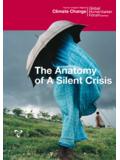Transcription of Food Security in Africa: Challenges and Prospects
1 REGIONAL SUSTAINABLE DEVELOPMENT REVIEW: africa food Security in africa : Challenges and Prospects - Emmanuel K. Boon food Security IN africa : Challenges AND Prospects . Emmanuel K. Boon Management and Environmental Management, Free University of Brussels, Belgium, and University of Ghana, Legon-Accra, Ghana. Keywords : Biotechnology, Coping strategies, food Security , Genetic diversity, Genetically Modified Organisms, Globalisation, Good governance, Livelihoods, Malnutrition, Poverty, Sustainable agriculture Contents 1. Introduction 2. The Concept of food Security 3. Principal Agricultural Systems and Impact on food Security 4. Agricultural Systems, Poverty, food Security and Hunger S. 5. food Security Critical Factors in africa S. 6. Conclusion LS. R. Glossary Bibliography TE.
2 Biographical Sketch O. Summary -E. AP. food insecurity and hunger are widespread in sub-Saharan africa (SSA). food Security O. implies the provision of safe, nutritious, and quantitatively and qualitatively adequate food , as well as access to it by all people. The chronic food insecurity in SSA is largely H. SC. due to the fact that 85-90 per cent of agriculture is rain-fed and accounts for 35 percent C. of the region's gross national product (GNP), 40 percent of exports and 70 percent of employment (World bank 2000). Domestic food production accounts for about 80. percent of the region's consumption (UNEP 2002:289). The yield of roots and tubers in E. E. africa is the lowest in comparison to the other regions of the world (McGranahm et al N. 1999:104). However, an estimated 40 percent of people in SSA live below the poverty PL.
3 Line, and both income and human poverty are increasing (UNEP 2002: 16). This paper U. examines these complex sustainable development problems and suggests appropriate measures for reducing poverty, ensuring food Security , fighting hunger and promoting a M. sustainable management of natural resources. The paper argues that the principles of sustainable agriculture and rural development (SARD) enunciated in the den Bosch SA. Declaration (FAO 1996:39) constitute the foundation for achieving food Security in africa . 1. Introduction africa faces a number of critical Challenges . According to Klaus Topfer (UNEP 2002 : XV), the environment continues to deteriorate ; social and economic inequality is increasing ; and globalisation is sweeping across the world, largely leaving africa behind.
4 Rapid changes in the global economy, in consumption patterns and in population and demographics are having a negative impact on the environment. In spite of the introduction of economic reforms in many Sub-Saharan African (SSA) countries, Encyclopedia of Life Support Systems (EOLSS). REGIONAL SUSTAINABLE DEVELOPMENT REVIEW: africa food Security in africa : Challenges and Prospects - Emmanuel K. Boon economic growth continues to be sluggish or negative, impacting heavily on the welfare of the people, especially the rural population. In addition, major environmental disasters in the continent such as recurrent drought and floods have serious devastating socio- economic and ecological impacts. Poor land policies and management practices, which lead to land degradation and deforestation, contribute to increased flood disasters in some risk areas.
5 A clear outcome of these nefaste processes is a significant decline in agricultural production, poverty and food insecurity. Agriculture, of which 85-90 per cent is rain-fed in sub-Saharan africa , accounts for 35 percent of the region's gross national product (GNP), 40 percent of exports and 70 percent of employment (World bank 2000). Year- to-year swings in GDP can be as high as 15-20 percent, largely due to the effects of fluctutations in rainfall on agricultural production. About one-third of the region has a mean annual rainfall of less than 700 mm, which is too little to sustainably support rain- fed crop production. In SSA, domestic food production accounts for about 80 percent of S. consumption (UNEP 2002 : 289). S. LS. The Research Problem, Objectives and Premises R.
6 TE. An estimated 40 percent of people in SSA live below the poverty line, and both income O. and human poverty are increasing (UNEP 2002 : 16). Using the Human Development Index (HDI) as a measure of the quality of life, in 2000 there were no African countries -E. in the high HDI group. A number of countries were in the medium HDI group, while AP. the majority were ranked in the low HDI group. Forecasts indicate that human O. vulnerability in africa is set to worsen in the future. This will lead to increasing poverty ; less attention being paid to the environment ; women and children will H. SC. continue to bear the brunt of environmental change ; migration and brain drain will intensify ; and the overexploitation of the environment will be accelerated. C. This paper analyses food insecurity and related problems in SSA in general and Ghana E.
7 E. in particular and proposes the adoption of strategic measures to mitigate human and N. environmental vulnerability. It argues that ensuring food Security is a key strategy for PL. achieving this objective. Projections on food production estimate that africa as a whole U. needs to increase its grain production by almost four times and its animal production by seven times, given a population of 2,200 million in the year 2050 (McGranahm et el M. 1999:104). Ideas on how to meet this challenge vary enormously; some are optimistic, even complacent, others are darkly pessimistic. Some indicate that not much needs to SA. change; others argue for fundamental reforms to agricultural and food systems. Some indicate that a significant growth in food production will only occur if new land is taken under the plough; others suggest that there are feasible social and technical solutions that would increase yields from existing farmland.
8 The guiding premise of this paper is that without deliberate changes from the normal course of events, many of the food Security problems of today will persist and some will become worse. Action needs to betaken now to promote poverty-reducing growth and agricultural development as well as to put agriculture on to a more sustainable path. A. second hypothesis of the paper is that modern agriculture undermines food Security and health by putting the rural poor at a disadvantage, threatening their land tenure, and Encyclopedia of Life Support Systems (EOLSS). REGIONAL SUSTAINABLE DEVELOPMENT REVIEW: africa food Security in africa : Challenges and Prospects - Emmanuel K. Boon degrading wild resources. Agricultural production in the future therefore needs to take into consideration the issue of sustainability.
9 2. The Concept of food Security According to the World food Summit organised in Rome in 1996, food Security exists when all people, at all times, have physical and economic access to sufficient, safe and nuritious food to meet their dietary needs and food preferences for an active and healthy life (FAO 2001 : 4). Tracking trends in food Security requires two interrelated variables (FAO 1996a, Vol 1, Ch2 :3). The first is the per caput availability of food for direct human consumption (also called per caput food supplies). It can be used to construct the pattern of world distribution of food supplies to show what part of the world's population lives in countries with given levels of per caput food supplies for consumption. S. The second variable concerns the distribution of the food supplies within each country, S.
10 Given the national average of the prceding variable, what proportion of a country's LS. population has access to any given level of per caput food supplies. One such relevant R. level for food Security analysis is that of per caput food supplies (Calories/day) equal to TE. times the basal metabolic rate (BMR). If a person's access to food is below this O. level, s/he may be classified as chronically undernourished. From 1969 to 1971, 900. million people in the developing countries (35 percent of their total population) were so -E. classified. By 1988-1990, the proportion had fallen to 20 percent, but there were still AP. about 800 million undernourished people, given that the population of the developing O. countries had in the meantime increased from to billion. H. SC. food Security , therefore, implies the provision of safe, nutritious , and quantitatively and qualitatively adequate food , as well as access to it by all people.
















